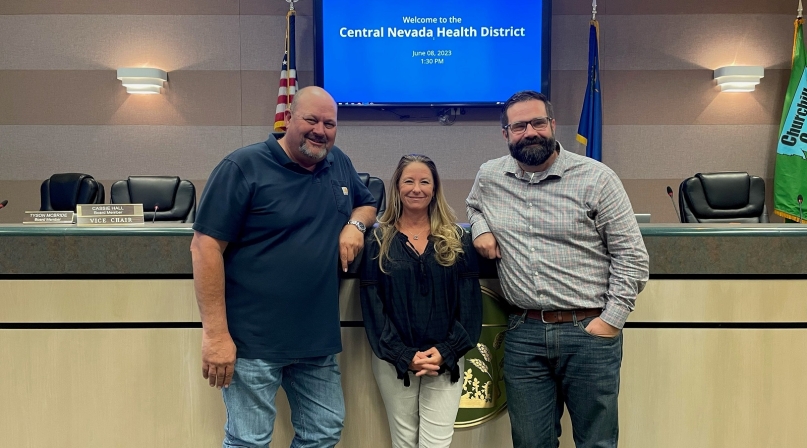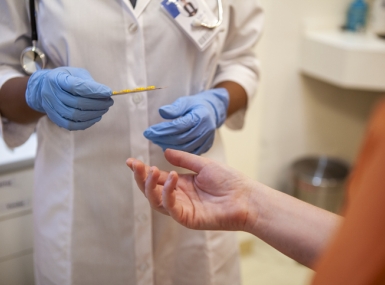Rural Nevada counties boost services with new health district

Key Takeaways
Four rural Nevada counties take their training wheels off on July 1.
That’s when they’ll leave the safe but inadequate health service agreement with the state and form their own health district, the first to cover rural counties.
Ever since their work during the COVID-19 pandemic gave officials the confidence to handle their own health services, county officials in Churchill County say they believed that local control was within reach. Pershing, Mineral and Eureka counties and the city of Fallon will join Churchill County.
“The state’s a great resource and a great partner in a lot of ways, but we can do this better,” said Caleb Cage, interim director of the health district. “The state has been talking about establishing rural districts since at least 2007, but it’s the counties that are actually making it happen.”
Although urban Clark and Washoe counties have health districts, Central Nevada Health District will be first to represent the needs of rural counties and the first to span multiple counties. Those needs include public health preparedness, nursing, preventable diseases, food safety, permitting and aging services.
An emergency order in May 2020 allowed Churchill County to create a public health department within its social services department to handle COVID testing, contact tracing and vaccine delivery. Those successes built momentum, and by late 2021, the wheels were in motion for the health district to start providing mandated services and more within two years.
“We had more capacity than we knew, and the community was open to all of it,” said Shannon Ernst, Churchill County’s social services director. The 25,000-resident county’s nominal board of health meets for roughly five minutes twice a year, Ernst said, satisfying state statute but not accomplishing anything of substance.
J.J. Goicoechea was involved in the health district planning while he was a Eureka County commissioner and he said that what would seem like a modest level of service anywhere else would be a dramatic improvement to what his county received from the state. His county is home to a population of nearly 1,900, spread over 4,200 square miles. He’s now the state’s secretary of agriculture. Pershing County has 6,600 residents and Mineral County has 4,500.
“It was mainly environmental services, like inspections, and I don’t know how good of a job they’re doing on some of that. They’re stretched pretty thin,” he said, noting staffing challenges at the county’s northern clinic. “We have a large elderly population out there and we’ve got a lot of very remote people out across rural Eureka County and we just can’t reach them.
“We don’t have a lot of social services out here and there’s basically no mental health support.”
The governments involved in the district found themselves bound by shared priorities to improve their health services. Eureka, Pershing and Mineral counties have all wanted better community health nursing support for years.
“I think there was a trust earned through the pandemic that naturally transferred to this conversation,” said Churchill County Manager Jim Barbee.
Ernst has done extensive tours of the partner counties to evaluate their needs, and while the pandemic has accelerated technological adoption on the service-provider side, she noted that hasn’t followed suit for residents, leaving many with unattractive options including for environmental health services.
“You have to go online or go to Carson City to get a permit,” she said. “We are making sure that within each community, there’s a representative there five days a week. Residents want to know that they matter, and they can talk to somebody physically.”
Local control of health services will also make them more accountable to the people they serve, Barbee said.
“If I’m in Eureka, trying to call the number somewhere in Carson City that’s under an agreement with the State Board of Health with whom I have no connection… they’re not folks that I see in the grocery store. For right or wrong, it’s just reality of the structure, and so I think that local communities having access to those implementing those services and protecting those communities is a significant improvement.”
Each county and Fallon will have two members on the district’s board of health. Health district staff will be Churchill County employees, with a goal of having a clinical manager, one registered nurse, one advanced practice registered nurse, one or two medical assistants and one community health worker in each community, along with an administrator and clerical specialist in each. The district also aims to hire financial specialists, two public health staff members and two environmental services staff.
The district’s first goal, however, is reaching the staffing level to ensure continuity of services provided by the state by the July 1 changeover. After that, services will expand with staffing, while the district works to partner with existing providers.
“When we look at non-mandated services, we are obtaining additional grant funding for services and the goal is to offer services in each community, such as tobacco, but if there is a coalition already providing that, we will partner to support their efforts and fill gaps they cannot provide,” Ernst said.
The district will take charge of existing office space, which varies from a room in Eureka County to a house in Mineral County to a new building that Churchill County is pursuing, which would serve as the administrative center. A $100,000 buy-in by each community plus a $5 per capita fee will fund the district. A 20 percent contingency payment will create an additional $200,000 account.
“This comes at a greater cost to the local community,” Cage said. “These communities could have maintained the status quo and just hoped there’s not another pandemic, but they didn’t do that. Very often in Nevada, because budgets are so tight and the opportunity to develop new tax revenue resources is so limited, money is the limiting factor. These communities said, ‘We want this even though it’s going to cost us more money to pull this off in a local fashion.’”
Goicoechea sees it being a major boon for his county and others.
“It will give us a chance to be more proactive and not just reactive,” he said. “If they’re doing homebound food delivery, we want a nurse embedded in these communities at least every couple of weeks who has a relationship with them and they feel comfortable enough to talk to them.
“A lot of people don’t know what their blood pressure is or they need to have their meds straightened out. It will be simple basic things that a lot of people take for granted in other areas.”
Attachments
Related News

U.S. House reintroduces legislation to address the Medicaid Inmate Exclusion Policy
Two bipartisan bills aimed at addressing the Medicaid Inmate Exclusion Policy (MIEP) were recently reintroduced in the U.S. House of Representatives.

House E&C Committee advances SUPPORT Act reauthorization
On April 9, the U.S. House Energy and Commerce Committee marked up the SUPPORT for Patients and Communities Reauthorization Act of 2025. The bipartisan bill aims to reauthorize critical programs that target overdose prevention amid the renewal of the opioid crisis Public Health Emergency declaration.

Bird flu update: What county leaders should know
As of April 7, there have been 70 confirmed cases of bird flu in the United States, but no person-to-person spread has been detected.
